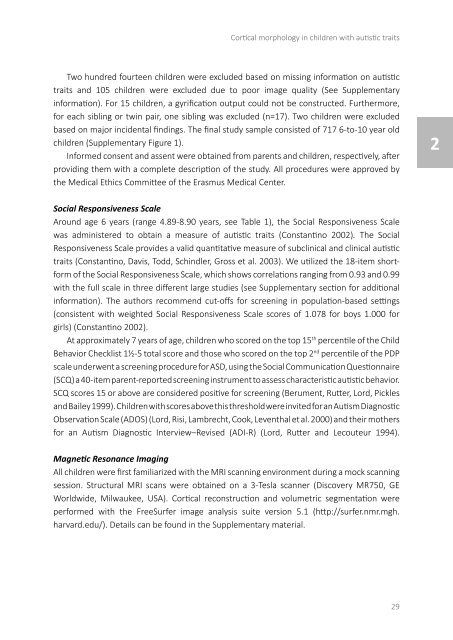On the Spectrum
2lm5UyR
2lm5UyR
Create successful ePaper yourself
Turn your PDF publications into a flip-book with our unique Google optimized e-Paper software.
Cortical morphology in children with autistic traits<br />
Two hundred fourteen children were excluded based on missing information on autistic<br />
traits and 105 children were excluded due to poor image quality (See Supplementary<br />
information). For 15 children, a gyrification output could not be constructed. Fur<strong>the</strong>rmore,<br />
for each sibling or twin pair, one sibling was excluded (n=17). Two children were excluded<br />
based on major incidental findings. The final study sample consisted of 717 6-to-10 year old<br />
children (Supplementary Figure 1).<br />
Informed consent and assent were obtained from parents and children, respectively, after<br />
providing <strong>the</strong>m with a complete description of <strong>the</strong> study. All procedures were approved by<br />
<strong>the</strong> Medical Ethics Committee of <strong>the</strong> Erasmus Medical Center.<br />
2<br />
Social Responsiveness Scale<br />
Around age 6 years (range 4.89-8.90 years, see Table 1), <strong>the</strong> Social Responsiveness Scale<br />
was administered to obtain a measure of autistic traits (Constantino 2002). The Social<br />
Responsiveness Scale provides a valid quantitative measure of subclinical and clinical autistic<br />
traits (Constantino, Davis, Todd, Schindler, Gross et al. 2003). We utilized <strong>the</strong> 18-item shortform<br />
of <strong>the</strong> Social Responsiveness Scale, which shows correlations ranging from 0.93 and 0.99<br />
with <strong>the</strong> full scale in three different large studies (see Supplementary section for additional<br />
information). The authors recommend cut-offs for screening in population-based settings<br />
(consistent with weighted Social Responsiveness Scale scores of 1.078 for boys 1.000 for<br />
girls) (Constantino 2002).<br />
At approximately 7 years of age, children who scored on <strong>the</strong> top 15 th percentile of <strong>the</strong> Child<br />
Behavior Checklist 1½-5 total score and those who scored on <strong>the</strong> top 2 nd percentile of <strong>the</strong> PDP<br />
scale underwent a screening procedure for ASD, using <strong>the</strong> Social Communication Questionnaire<br />
(SCQ) a 40-item parent-reported screening instrument to assess characteristic autistic behavior.<br />
SCQ scores 15 or above are considered positive for screening (Berument, Rutter, Lord, Pickles<br />
and Bailey 1999). Children with scores above this threshold were invited for an Autism Diagnostic<br />
Observation Scale (ADOS) (Lord, Risi, Lambrecht, Cook, Leventhal et al. 2000) and <strong>the</strong>ir mo<strong>the</strong>rs<br />
for an Autism Diagnostic Interview–Revised (ADI-R) (Lord, Rutter and Lecouteur 1994).<br />
Magnetic Resonance Imaging<br />
All children were first familiarized with <strong>the</strong> MRI scanning environment during a mock scanning<br />
session. Structural MRI scans were obtained on a 3-Tesla scanner (Discovery MR750, GE<br />
Worldwide, Milwaukee, USA). Cortical reconstruction and volumetric segmentation were<br />
performed with <strong>the</strong> FreeSurfer image analysis suite version 5.1 (http://surfer.nmr.mgh.<br />
harvard.edu/). Details can be found in <strong>the</strong> Supplementary material.<br />
29


